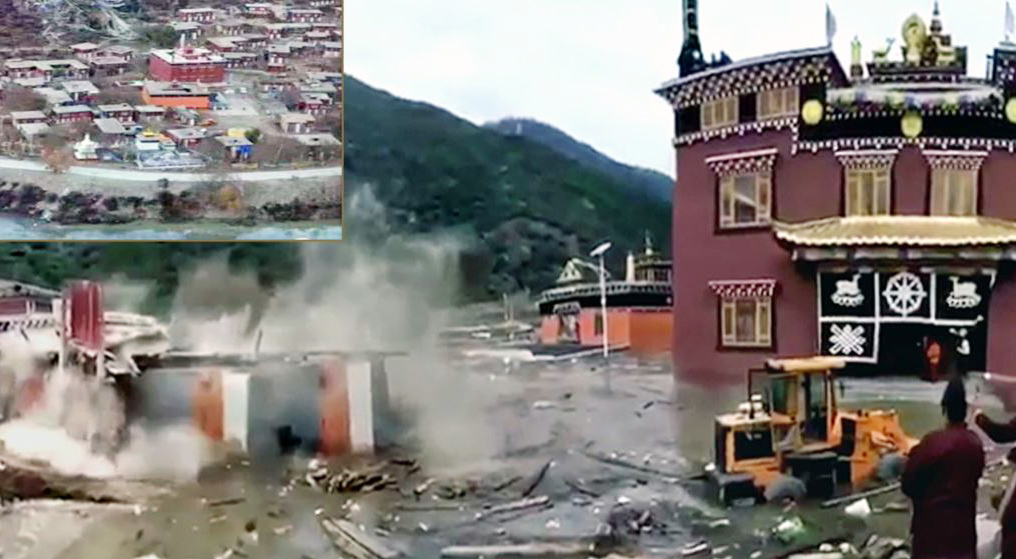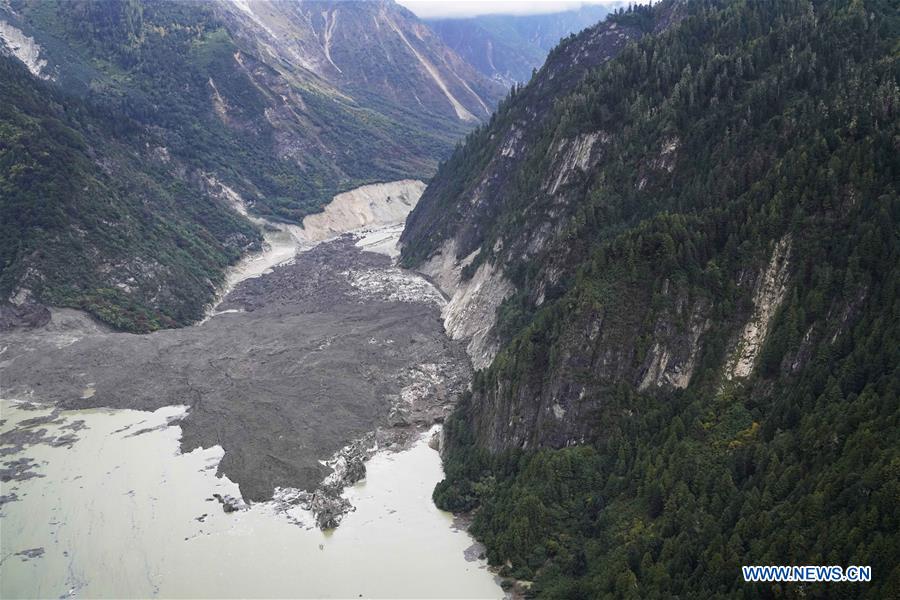
Po (Polu) Monastery partly submerged by the river Photo: VOA
The face of a mountainside near Bolo Township in Jomda County, Eastern Tibet collapsed into the Drichu River (the Yangste in Chinese)on October 11, blocking the river and forming a huge barrier lake 5km long, 200 metres wide and 70 metres deep. Two villages were submerged but – had the barrier-dam burst – the consequences could have been very much worse. 13,600 people were reported to have been evacuated from the immediate area, together with a further 11,000 from neighbouring Sichuan Province. On October 13 the Chinese Government’s Ministry of Emergency Management warned that another landslide could be imminent, with a 300 metre-long crack appearing on the same mountain. Water was discharged from the lake, flooding the Po township, the Po monastery and settlements downstream but avoiding any deaths or injuries. By October 14 water levels had returned to normal.
A second landslide occurred in the vicinity of Bolo township on November 3, again blocking the Drichu River and forming a barrier lake, inundating two villages and a hydro-electric power station. Chinese media reported that 6,000 people were evacuated within 24 hours. The two landslides and subsequent flooding destroyed 100 houses, damaged 1,000 more and, at that stage, 8,300 people had been relocated – many more were to follow.
However waters in the second barrier lake continued to rise – increasing to a depth of 55 metres and an estimated volume of 470 million cubic metres by November 11 – with fears of potentially catastrophic flooding should it burst. Chinese state news media Xinhua reported that 67,500 people were evacuated by November 13 when a man-made channel was made on the Drichu in order to discharge the excess water. There were no reported casualties, however the 270 metre-long, “Zhubalong Jinsha River Bridge” downstream in Karze was washed away, 8,000 houses were damaged and 1,800 hectares of farmland were inundated in the resulting flood waters.
A week after the first incident on the Drichu River, on October 17, a separate landslide was reported on the Yarlung Tsangpo headwater of the Brahmaputra River near Menling County. Waters in the resulting barrier lake rose 40 metres and 6,000 people were evacuated as a precaution. The Chinese authorities warned regions downstream – including the Indian state of Arunchal Pradesh – of the danger of serious flash floods.

Landslide at Yarlung Tsanpo Photo: Xinhua
These landslides have had a ruinous impact on the environment but at least – as so far reported – there have been no fatalities. The welfare of the people in the area – and the protection of property, as far as possible – were the initial priority. Tempa Gyaltsen Zamlha, a Research Fellow from the Tibetan Policy Institute of the Central Tibetan Administration based in Dharamshala, is an authority on environmental issues in Tibet. He has been highly critical of the Chinese authorities’response to these disasters, arguing that a more urgent and better-resourced reaction could have provided a deeper understanding of the problem and brought quicker relief to the tens of thousands of people affected.
These events raise a number of serious questions that remain unanswered:
• Do we have accurate information on these incidents?
• What might be the cause(s)?
• What might be done to prevent further such disasters – or at least mitigate their impact?
• What other environmental hazards threaten the fragile and precious eco-system of the Tibetan Plateau?
Information on these landslides – and the consequent flooding and evacuations – is gathered from social media from the area, the official Chinese media (China Daily; Xinhua and others) and statements issued by Chinese government ministries. However the Chinese media report in English, Tibetan and Chinese and the content can vary from one language to another. Therefore the precise details of the timing and severity of these accidents – and their impact on local people – is not entirely clear.
Why are these landslides happening – and why now? Many local people believe that they are triggered by mining in the area and hydro-electric power installations. However Tempa Gyaltsen Zamlha believes that the landslides were caused by number of factors: principally excessive construction work; road-building and possible tunneling in the area.
The United Kingdom-based organisation Free Tibet released a report on October 15 which stated,“The Drichu River has been an essential component in a series of Chinese large-scale hydro-dam development projects at the Tibetan Plateau’s southeast corner. Aimed
at meeting the increasing electricity demands of distant Chinese cities, the hydro-dam constructions are not there to benefit the local Tibetan population.”
Alongside environmental degradation and disruption of the unique ecosystems, Free Tibet cited various reports of forced migration for dam construction in the Tibetan regions, with more than 17,000 Tibetans having been moved out of their homes.
Along with these immediate causes might wider, long-term factors be at play? Global warming is resulting in the retreat of glaciers in Tibet (the third largest source of ice on the planet, after the South and North Poles) and the reduction in permafrost across the region. Might these factors – together with changing weather patterns – be exacerbating the impact of indiscriminate construction and exploitation projects?
 Tempa Gyaltsen Zamlha – who presented a series of Case Studies on The Violation of the Socio-Environmental Rights of the Tibetan People to the Geneva Forum, 37th United Nations High Commission for Refugees (HCR)session in November – points out that these recent landslides did not occur at the time of year that might be expected. They did not happen during or immediately after the heavy rains of the monsoon season which can destabilise the land with heavy, water-logged sub-soils – these happened much later in the year. The reasons for these incidents may well be complex and it would seem apposite that the Chinese authorities should devote expertise and resources to thoroughly investigate and understand the causes and establish what can be done to prevent further occurrences.
Tempa Gyaltsen Zamlha – who presented a series of Case Studies on The Violation of the Socio-Environmental Rights of the Tibetan People to the Geneva Forum, 37th United Nations High Commission for Refugees (HCR)session in November – points out that these recent landslides did not occur at the time of year that might be expected. They did not happen during or immediately after the heavy rains of the monsoon season which can destabilise the land with heavy, water-logged sub-soils – these happened much later in the year. The reasons for these incidents may well be complex and it would seem apposite that the Chinese authorities should devote expertise and resources to thoroughly investigate and understand the causes and establish what can be done to prevent further occurrences.
Climatic change is underway and unavoidable –resulting in rising temperatures and reduced snowfall on the Tibetan Plateau. This could lead to other environmental disasters such as forest fires and the massive problems that these could bring: damage to life and property; pollution; deforestation; erosion; degradation of water courses; threats to wildlife etc. So, Mr Gyaltsen argues that adaptation to these changes and mitigation of their negative impacts – through scientific understanding, public education, modification of building techniques, together with sensitive and sustainable development – must be adopted as a major policy and a top priority of the Chinese Government.
Without these actions the dramatic landslides of the last few weeks may just be a foretaste of the environmental catastrophes to come on the Tibetan Plateau.




 Print
Print Email
Email